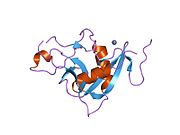REG3A
Regenerating islet-derived protein 3 alpha (or Regenerating islet-derived protein III-alpha) formerly known as HIP/PAP (Hepatocarcinoma-Intestine-Pancreas/Pancreatitis-Associated Protein) and peptide 23[5] is a protein that in humans is encoded by the REG3A gene.[6][7]
This gene encodes a pancreatic secretory protein that may be involved in cell proliferation or differentiation. It has similarity to the C-type lectin superfamily. The enhanced expression of this gene is observed during pancreatic inflammation and liver carcinogenesis. Multiple alternatively spliced transcript variants encoding the same protein have been described for this gene but the full length nature of some transcripts is not yet known.[7]
Reg3A (UniProt Q0614 1) is a bactericidal C-type lectin that is constitutively produced in the intestine that has antibacterial properties against Gram-positive bacteria. Bacterial killing is mediated by binding to surface-exposed carbohydrate moieties of bacterial peptidoglycan and executed by the formation of a hexameric pore in the membrane.[8][9][10]
References
[edit]- ^ a b c GRCh38: Ensembl release 89: ENSG00000172016 – Ensembl, May 2017
- ^ a b c GRCm38: Ensembl release 89: ENSMUSG00000071356 – Ensembl, May 2017
- ^ "Human PubMed Reference:". National Center for Biotechnology Information, U.S. National Library of Medicine.
- ^ "Mouse PubMed Reference:". National Center for Biotechnology Information, U.S. National Library of Medicine.
- ^ Chakraborty C, Sharma S, Katsumata N, Murphy LJ, Schroedter IC, Robertson MC, et al. (June 1995). "Plasma clearance, tissue uptake and expression of pituitary peptide 23/pancreatitis-associated protein in the rat". The Journal of Endocrinology. 145 (3): 461–469. doi:10.1677/joe.0.1450461. PMID 7636430.
- ^ Dusetti NJ, Frigerio JM, Fox MF, Swallow DM, Dagorn JC, Iovanna JL (January 1994). "Molecular cloning, genomic organization, and chromosomal localization of the human pancreatitis-associated protein (PAP) gene". Genomics. 19 (1): 108–114. doi:10.1006/geno.1994.1019. PMID 8188210.
- ^ a b "Entrez Gene: REG3A regenerating islet-derived 3 alpha".
- ^ Murphy K, Weaver C (2017). Janeway's Immunobiology. Garland Science. p. 48. ISBN 978-0-8153-4505-3.
- ^ Cash HL, Whitham CV, Behrendt CL, Hooper LV (August 2006). "Symbiotic bacteria direct expression of an intestinal bactericidal lectin". Science. 313 (5790): 1126–1130. Bibcode:2006Sci...313.1126C. doi:10.1126/science.1127119. PMC 2716667. PMID 16931762.
- ^ Vaishnava S, Yamamoto M, Severson KM, Ruhn KA, Yu X, Koren O, et al. (October 2011). "The antibacterial lectin RegIIIgamma promotes the spatial segregation of microbiota and host in the intestine". Science. 334 (6053): 255–258. Bibcode:2011Sci...334..255V. doi:10.1126/science.1209791. PMC 3321924. PMID 21998396.
Further reading
[edit]- Lasserre C, Christa L, Simon MT, Vernier P, Bréchot C (September 1992). "A novel gene (HIP) activated in human primary liver cancer". Cancer Research. 52 (18): 5089–5095. PMID 1325291.
- Orelle B, Keim V, Masciotra L, Dagorn JC, Iovanna JL (December 1992). "Human pancreatitis-associated protein. Messenger RNA cloning and expression in pancreatic diseases". The Journal of Clinical Investigation. 90 (6): 2284–2291. doi:10.1172/JCI116115. PMC 443380. PMID 1469087.
- Itoh T, Teraoka H (February 1993). "Cloning and tissue-specific expression of cDNAs for the human and mouse homologues of rat pancreatitis-associated protein (PAP)". Biochimica et Biophysica Acta (BBA) - Gene Structure and Expression. 1172 (1–2): 184–186. doi:10.1016/0167-4781(93)90290-t. PMID 7679928.
- Itoh T, Sawabu N, Motoo Y, Funakoshi A, Teraoka H (April 1995). "The human pancreatitis-associated protein (PAP)-encoding gene generates multiple transcripts through alternative use of 5' exons". Gene. 155 (2): 283–287. doi:10.1016/0378-1119(94)00799-X. PMID 7721106.
- Lasserre C, Simon MT, Ishikawa H, Diriong S, Nguyen VC, Christa L, et al. (August 1994). "Structural organization and chromosomal localization of a human gene (HIP/PAP) encoding a C-type lectin overexpressed in primary liver cancer". European Journal of Biochemistry. 224 (1): 29–38. doi:10.1111/j.1432-1033.1994.tb19991.x. PMID 8076648.
- Christa L, Carnot F, Simon MT, Levavasseur F, Stinnakre MG, Lasserre C, et al. (December 1996). "HIP/PAP is an adhesive protein expressed in hepatocarcinoma, normal Paneth, and pancreatic cells". The American Journal of Physiology. 271 (6 Pt 1): G993-1002. doi:10.1152/ajpgi.1996.271.6.G993. PMID 8997243.
- Rafaeloff R, Pittenger GL, Barlow SW, Qin XF, Yan B, Rosenberg L, et al. (May 1997). "Cloning and sequencing of the pancreatic islet neogenesis associated protein (INGAP) gene and its expression in islet neogenesis in hamsters". The Journal of Clinical Investigation. 99 (9): 2100–2109. doi:10.1172/JCI119383. PMC 508040. PMID 9151782.
- Bödeker H, Keim V, Fiedler F, Dagorn JC, Iovanna JL (2000). "PAP I interacts with itself, PAP II, PAP III, and lithostathine/regIalpha". Molecular Cell Biology Research Communications. 2 (3): 150–154. doi:10.1006/mcbr.1999.0166. PMID 10662590.
- Graf R, Schiesser M, Scheele GA, Marquardt K, Frick TW, Ammann RW, Bimmler D (June 2001). "A family of 16-kDa pancreatic secretory stress proteins form highly organized fibrillar structures upon tryptic activation". The Journal of Biological Chemistry. 276 (24): 21028–21038. doi:10.1074/jbc.M010717200. PMID 11278730.
- Simon MT, Pauloin A, Normand G, Lieu HT, Mouly H, Pivert G, et al. (August 2003). "HIP/PAP stimulates liver regeneration after partial hepatectomy and combines mitogenic and anti-apoptotic functions through the PKA signaling pathway". FASEB Journal. 17 (11): 1441–1450. doi:10.1096/fj.02-1013com. PMID 12890698. S2CID 13990589.
- Lieu HT, Batteux F, Simon MT, Cortes A, Nicco C, Zavala F, et al. (September 2005). "HIP/PAP accelerates liver regeneration and protects against acetaminophen injury in mice". Hepatology. 42 (3): 618–626. doi:10.1002/hep.20845. PMID 16116631. S2CID 10970433.
- Rual JF, Venkatesan K, Hao T, Hirozane-Kishikawa T, Dricot A, Li N, et al. (October 2005). "Towards a proteome-scale map of the human protein-protein interaction network". Nature. 437 (7062): 1173–1178. Bibcode:2005Natur.437.1173R. doi:10.1038/nature04209. PMID 16189514. S2CID 4427026.
- Cash HL, Whitham CV, Behrendt CL, Hooper LV (August 2006). "Symbiotic bacteria direct expression of an intestinal bactericidal lectin". Science. 313 (5790): 1126–1130. Bibcode:2006Sci...313.1126C. doi:10.1126/science.1127119. PMC 2716667. PMID 16931762.
- Ho MR, Lou YC, Lin WC, Lyu PC, Huang WN, Chen C (November 2006). "Human pancreatitis-associated protein forms fibrillar aggregates with a native-like conformation". The Journal of Biological Chemistry. 281 (44): 33566–33576. doi:10.1074/jbc.M604513200. PMID 16963458.








